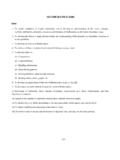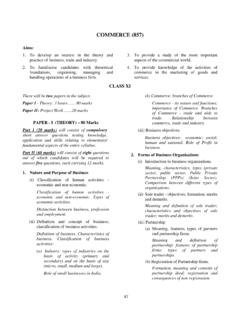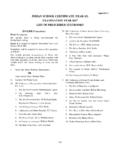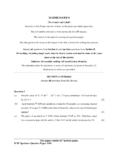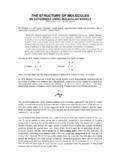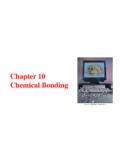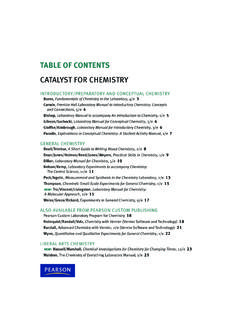Transcription of CORRIGENDUM: CHEMISTRY PRACTICAL (PAPER 2)
1 CORRIGENDUM: CHEMISTRY PRACTICAL (PAPER 2) Please be informed that the break up of marks for the assessment of Project Work and the PRACTICAL File for CHEMISTRY stands revised for the ISC Examination to be held in and after the year 2017. In the previous years, 10 marks (7 marks for Project work and 3 marks for PRACTICAL file) out of 30 marks were assigned for the Internal Assessment. However, the same stands revised as follows: Project work (to be assessed by the Visiting Examiner) 10 marks PRACTICAL File (to be assessed by the Visiting Examiner) 05 marks Total 15 marks In view of the change in the break-up of marks in the assessment of the Project Work and the PRACTICAL File, the PRACTICAL Papers in CHEMISTRY will now be assessed externally out of 15 marks, instead of 20 marks.
2 164 CHEMISTRY (862)Aims: 1. To foster acquisition of knowledge and understanding of terms, concepts, facts, processes, techniques and principles relating to the subject of CHEMISTRY . 2. To develop the ability to apply the knowledge of contents and principles of CHEMISTRY in new or unfamiliar situations. 3. To develop skills in proper handling of apparatus and chemicals. 4. To develop an ability to appreciate achievements in the field of CHEMISTRY and its role in nature and society. 5. To develop an interest in activities involving usage of the knowledge of CHEMISTRY . 6. To develop a scientific attitude through the study of Physical Sciences. 7. To acquaint students with the emerging frontiers and interdisciplinary aspects of the subject. 8. To develop skills relevant to the discipline.
3 9. To apprise students with interface of CHEMISTRY with other disciplines of Science, such as, Physics, Biology, Geology, Engineering, etc. CLASS XI There will be two papers in the subject. Paper I: Theory- 3 hours .. 70 marks Paper II: PRACTICAL - 3 hours ..20 marks Project Work .. 7 marks PRACTICAL File .. 3 marks PAPER 1- THEORY: 70 Marks There will be no overall choice in the paper. Candidates will be required to answer all questions. Internal choice will be available in two questions of 2 marks each, two questions of 3 marks each and all the three questions of 5 marks each. UNIT TOTAL WEIGHTAGE 1. Some Basic Concepts of CHEMISTRY Physical CHEMISTRY 32 Marks 2. Structure of Atom 3. Classification of Elements and Periodicity in Properties 4.
4 Chemical Bonding and Molecular Structure 5. States of Matter: Gases and Liquids 6. Chemical Thermodynamics 7. Equilibrium 8. Redox Reactions Inorganic CHEMISTRY 15 Marks 9. Hydrogen 10. s -Block Elements 11. Some p -Block Elements 12. Organic CHEMISTRY : Some basic Principles and Techniques Organic CHEMISTRY 23 Marks 13. Hydrocarbons 14. Environmental CHEMISTRY Total 70 Marks 165 PAPER I THEORY 70 Marks 1. Some Basic Concepts of CHEMISTRY General introduction: Importance and scope of CHEMISTRY . Study of matter. Understanding laws of chemical combination. Dalton's atomic theory: concept of elements, atoms and molecules. Isotopic (atomic) and molecular masses, mole concept and molar mass, percentage composition, empirical and molecular formula. Stoichiometry and calculations based on chemical reactions.
5 (i) Precision and accuracy: Quantities and their measurements in CHEMISTRY , significant figures, SI units. (ii) Dimensional analysis: Conversion of units, numericals and applications of units. (iii) The concept of atoms having fixed properties in explaining the laws of chemical combination. Study about atoms. Dalton s atomic theory: Main postulates of the theory; its limitations. Laws of chemical combinations: Law of conservation of mass. Law of definite proportions. Law of multiple proportions. Law of reciprocal proportions. Gay Lussac s law of gaseous volumes. Statement, explanation and simple problems based on these laws. (iv) Atomic (isotopic masses) and molecular mass. Relative molecular mass and mole: The atomic mass unit is one of the experimentally determined unit.
6 It is equal to 1/12 of the mass of the carbon 12 isotope. Numerical problems based on mole concept, Avogadro s number and gram molecular volume. (v) Empirical and molecular formula: Numericals based on the above. (vi)Chemical equivalents, volumetric calculations in terms of normality. C = should be taken as a standard for expressing atomic masses. Equivalent weight expressing the combining capacity of the elements with the standard elements such as H, Cl, O, Ag, etc. Variable equivalent weight. Gram equivalent weights, relationship between gram equivalent weight, gram molecular mass and valency. Determination of equivalent weight of acids, alkalis, salts, oxidising and reducing agents. (experimental details not required). Terms used in volumetric calculations such as percentage (w/w and w/v), normality, molarity, molality, mole fraction, etc.
7 Should be discussed. Students are required to know the formulae and normality and molarity equations. Simple calculations on the above topics. (vii)Chemical reactions stoichiometric calculations based on mass-mass, mass-volume, volume-volume relationships and limiting reagent. 2. Structure of Atom Discovery of fundamental particles electron, proton and neutron), atomic number, isotopes and isobars. Thomson's model and its limitations. Rutherford's experimental model and its limitations. Dual nature of matter and light. Bohr's atomic model and its limitations (de Broglie's equation, Heisenberg s uncertainty principle), concept of shells, subshells, orbitals. Quantum numbers, shapes of s, p and d orbitals. Rules for filling electrons in orbitals - aufbau principle, Pauli's exclusion principle and Hund's rule of maximum multiplicity.
8 Electronic configuration of atoms, stability of half- filled and completely filled orbitals. (i) Subatomic particles (electrons, protons and neutrons) their charges and masses: Concept of indivisibility of atom as proposed by Dalton does not exist. The atom consists of subatomic fundamental particles. Production of cathode rays and their properties. Production of anode rays and their properties. Chadwick s experiment for the discovery of neutron and properties of neutron. 166 (ii) Rutherford s nuclear model based on the scattering experiment: Rutherford s scattering experiment. Discovery of nucleus. Rutherford s nuclear model of atom. Defects of Rutherford s model. Electromagnetic wave theory and its limitations (Black body radiation and photoelectric effect) Planck s quantum theory.
9 Numericals based on the above. (iii) Types of spectra: emission and absorption spectra. Band and line spectra to be discussed. (iv) Bohr s atomic model. Postulates of Bohr s theory based on Planck s quantum theory. Merits of Bohr s atomic model and explanation of hydrogen spectra. Calculations based on Rydberg s formula. Numericals on Bohr s atomic radii, velocity and energy of orbits (derivation not required). Defects in Bohr s Model. (v) Quantum mechanical model of an atom - a simple mathematical treatment. Quantum numbers; shape, size and orientation of s, p and d orbitals only (no derivation). aufbau principle, Pauli s exclusion principle, Hund s rule of maximum multiplicity.
10 Electronic configuration of elements in terms of s, p, d, f subshells. de Broglie s equation. Numericals. Heisenberg s Uncertainty Principle. Numericals. Schrodinger Wave Equation physical significance of and | | 2. Quantum numbers types of quantum numbers, shape, size and orientation of the s, p and d subshells. Information obtained in terms of distance of electron from the nucleus, node, nodal planes and radial probability curve, energy of electron, number of electrons present in an orbit and an orbital. aufbau principle, (n+l) rule. Pauli s exclusion principle. Hund s rule of maximum multiplicity. Electronic configuration of elements and ions in terms of s, p, d, f subshells and stability of half-filled and completely filled orbitals.



